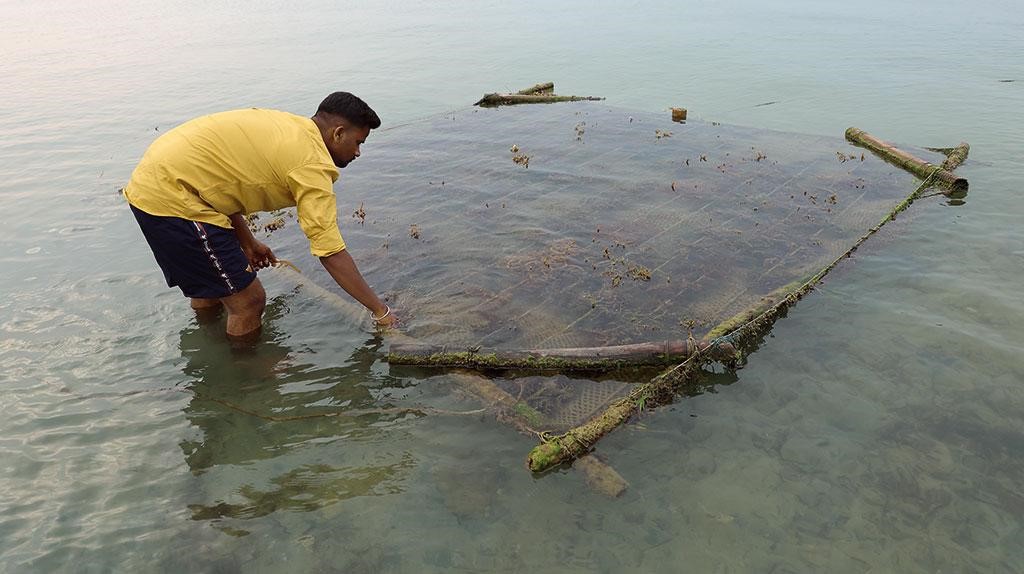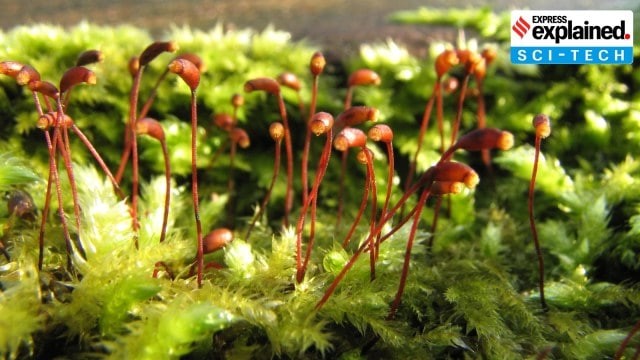Description

Disclaimer: Copyright infringement not intended.
Context: Corals usually come in shades of green, brown, pink, yellow, red or blue. But a snorkelling investigation of three coral colonies adjoining Kurusadai, one of the 21 uninhabited islands that form the Gulf of Mannar Marine National Park along the Tamil Nadu coastline, shows them to be grey and eerie.
Details:
The story:
- The 21 islands came under the control of the forest department in 1986, which established the national park — a 10,500 sq km reserve that is a habitat for the rare sea-cow, dolphin and dozens of coral species — the same year.
- Being a protected area, tourism was not allowed in the national park until March 2022, when Kurusadai opened its doors to tourists (the other 20 islands are still closed for visitors).
- The corals, which provide shelter to myriad marine life, protect against storms and support livelihoods through fisheries and tourism, could have been the star attraction. But they are dead.
- One of the prime threats that killed the corals near Kurusadai is Kappaphycus alvarezii.
- It is a seaweed (alga) species deliberately introduced in Ramanathapuram for commercial cultivation some two decades ago.
- The International Union for Conservation of Nature lists it as one of the world’s 100 most invasive species.
.jpeg)
Corals and seaweeds:
- Corals and seaweeds are constantly locked in a battle.
- This dynamic can be compared with trees and weeds growing in a forest.
- Marine algae seek corals since they provide support for growth. But live corals use their defence mechanisms to prevent a hostile takeover. Though corals can protect themselves from native seaweed, they lose to Kappaphycus.
- The seaweed is dangerous because it grows fast, doubling its size in 15-30 days, and seeks out live corals to thrive on — unlike native seaweeds, which typically grow on dead corals.
Seaweed Cultivation in India:
- In 2021, India cultivated around 34,000 tonnes of seaweed, as per the Indian Council of Agricultural Research-Central Marine Fisheries Research Institute.
- That same year, the Centre earmarked Rs 600 crore to increase seaweed production to 11.85 million tonnes by 2025.
- National research institutes and companies are for increased cultivation of Kappaphycusto improve livelihoods, profits and to reduce India’s import of kappa-carrageenan, a polysaccharide extracted from the alga that finds use in industrial gums and as a smoothening agent in ice cream, toothpaste, jellies, medicines and paint.
Commercial production of Kappaphycus:
- Commercial production of Kappaphycusbegan in the 1960s in the Philippines, the native land of the species. It has since been introduced in over 20 nations.
- Perhaps India should have been warned of the species’ invasive nature when it was introduced in Hawaii in the 1970s.
- The invasive species has also caused considerable damage to Coconut Island in Hawaii, Cubagua Island in Venezuela, Zanzibar in Tanzania, and Almirante and Cristobal in Panama and Costa Rica.
- India’s tryst with the controversial species began in 1984, when CSMCRI acquired a small part of Kappaphycus alvareziiof Philippine origin from Japan.
- In 2000, the institute transferred the technology of cultivating Kappaphycusto PepsiCo. The company introduced it to the northern part of the Gulf of Mannar Marine National Park without a proper environmental impact assessment (EIA).

About the National Park:
- The Gulf of Mannar Marine National Park is a protected area of India consisting of 21 small islands (islets) and adjacent coral reefs in the Gulf of Mannar in the Indian Ocean.
- It is the core area of the Gulf of Mannar Biosphere Reserve which includes a 10 km buffer zone around the park, including the populated coastal area.
- It was established as a National Park in 1986.
Flora:
- The park includes marine components such as coral reefs, seaweed communities, sea grasses, and mangroves.
- Mangroves dominate the intertidal zones of the park islands.
- The introduced tree genus Prosopis is dominant on land in all the islands.
- The flowering herb Pemphis acidula (family Lythraceae) is the only endemic plant species.
- This vegetation provides important feeding grounds for vulnerable marine mammals such as the dugong, endangered green turtles and olive ridley turtles.
Fauna:
- The dugong, a vulnerable marine mammal, is the flagship mammal of the park.
- About 510 (23%) of the 2,200 fin fish species in Indian waters are found in the Gulf, making it the most highly diverse fish habitat in India.
- A unique endemic species of Balanoglossus – Ptychodera fluva, a living fossil that links invertebrates and vertebrates, has been recorded only at Kurusadai.
Concerns:
- Large areas of these reefs are in generally poor condition due to destructive human activities of the 150,000 persons living along the coast.
- Nutrient and other pollution loads are high due to agriculture, deforestation, industry, urbanization and septic pollution. It appears that the coral reefs of the Gulf of Mannar Marine National Park seem to be healthy and in good condition, despite high rates of sedimentation and other threats.
- However, live coral cover is only about 35%. Various algae cover much of the dead coral.
- Stony coral species of families Poritidae and Faviidae constitute the dominant reef builders here.
- Coral reefs near some of the islands have been heavily damaged by exploitation as raw materials for industrial ventures such as cement industries, brick manufacture, masonry work and lime kilns.

About Kappaphycus alvarezii:
- Kappaphycus alvarezii, the elkhorn sea moss, is a species of red algae.
- It is a dark greenish-brown hue and can sometimes be deep purple. The moss is cylindrical in shape throughout the seaweed.
- The Elkhorn sea moss is located in the Pacific, French, and Indian Oceans, as well as the Caribbean sea, South China's sea. It is located on the islands of Hawaii and Guam
- The role this sea moss plays in its native habitat is to feed the fish in the surrounding area. It also produces and releases certain minerals which benefit the habitat in which it inhabits.
- It can also loosely attach itself to the coral. They can form large unattached fragments that can form a mat like structure. This algal mat can act as UV protection for fish and act as a source of food for the surrounding aquatic life.
History as an invasive species:
- This alga is an introduced species and a noxious aquatic weed in Hawaii.
- This species was considered an introduced many countries with the sole main purpose of increasing the commercial aquaculture carrageenan industry; the carrageenan is a biopolymer extracted from algae and used extensively in the food industry for the formation of gels to stabilize fat in food with dairy products.
|
PRACTICE QUESTION
Q) Which of the following statements is/are correct with reference to Gulf of Mannar Marine National Park?
a. The dugong, a vulnerable marine mammal, is the flagship mammal of the park.
b. It is the most highly diverse fish habitat in India.
- Only a
- Only b
- Both a and b
- Neither a nor b
Answer: Option 3
|

https://www.downtoearth.org.in/news/environment/coral-breach-a-silent-catastrophic-invasion-has-happened-in-the-gulf-of-mannar-here-is-how-87837












